

|
Home Updates Hydros Cars Engines Contacts Links ←Pit Box 20 Pit Box 22→ Pit Box Index |
|
Pitbox 2021 |
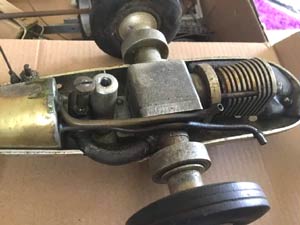 |
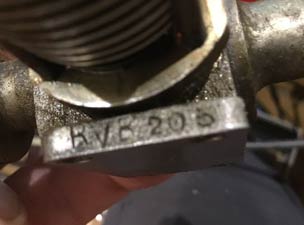 |
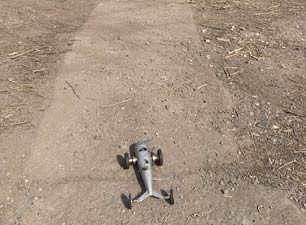 |
| Early Oliver
This motor is of interest in its own right
as it one of the very first production, ball raced,
Oliver twinshafts. The curly carb, still on the right on the MkIs,
would indicate that it came from someone of serious racing
intent, as does the four bolt cylinder modification, research continues on this front. What has caused
confusion is the serial number of RVB 205. This would seem to
indicate that numbers started from 200 again for the RVBs and
possibly 200 for the RVs rather than the numbers being continued
from the DV versions and just the prefix added? There is
then the probability that there is an RV 205 out there as well
and begs the question as to just how many Tiger MkIs were
actually produced? |
||
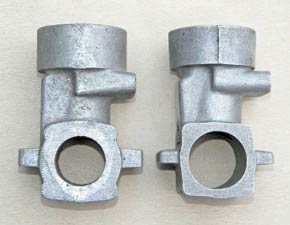 |
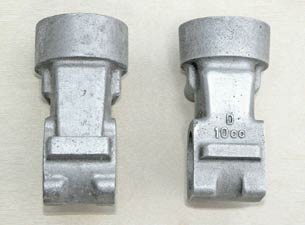 |
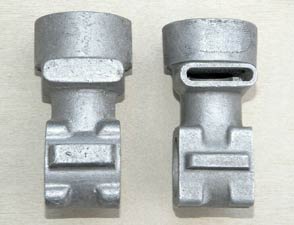 |
|
Wood or Nordec? These two sets of
castings threw up all sorts of questions regarding the
development of the Nordec motor and the work of John Wood,
North Downs Engineering workshop
manager and speed flyer. With the monoblock casting was this a
prototype for the Nordec Series II or actually John Wood's own
motor that he built and used after the closure of the Company.
John continued flying long after North Downs closed with what
was described in 1950 as 'An entirely new engine by John Wood of the Croydon
Club'. So might these castings have been been for the Wood 10, basically a sand
cast Nordec Series II with a Dooling style rear end? Too many
similarities in the castings to be a coincidence. |
||
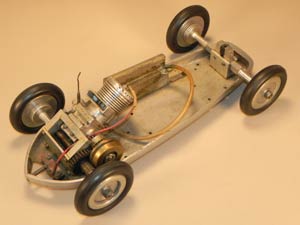 |
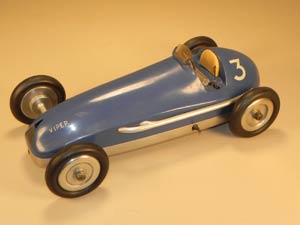 |
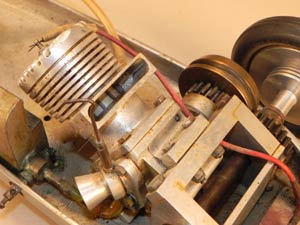 |
| Viper:
This fascinating car is believed to be the
last of several cars produced by Mr King of the Pioneer Club. He
is better known for his smaller and home built diesel cars,
including a tiny twinshaft version that is well documented.
Viper is all together a much more serious undertaking as the
Hornet like motor is entirely handbuilt and fabricated from bar
stock, as is the spur mount. The front suspension system was
still in evidence in FEMA cars, well into the 1960s. There is no
evidence that the car ever ran in anger and migrated to the US
at some stage, where it remains currently, having changed hands
a few times. |
||
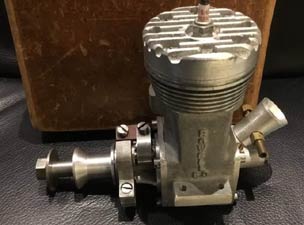 |
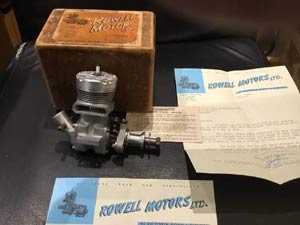 |
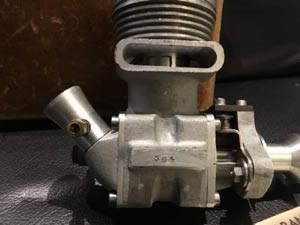 |
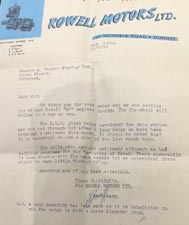 |
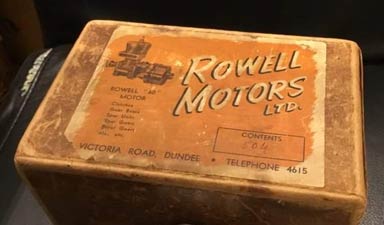 |
|
| Collector's dream:
Not often that an engine of this quality
turns up. The Rowell MkII Series 2 is rare enough on its own,
but to find one new, in its box, with all the original
paperwork, guarantee and all numbers matching is a dream find.
The number 504 makes it one of the first of this series with the
enclosed letter dated May 1949. The flywheel that was ordered
with the engine was due to follow in 'a day or two' while the
KLG plug and coil should be available 'this month'. A prop
driver was included 'as it is beneficial to run the motor in
with a large diameter prop'. This motor, along with MkI #111
were offered for sale on ebay but struggled to make what seemed
a very realistic price, given the originality. |
||
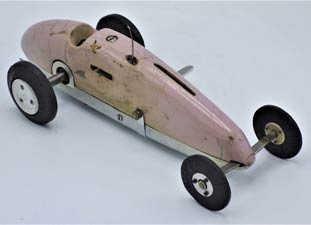 |
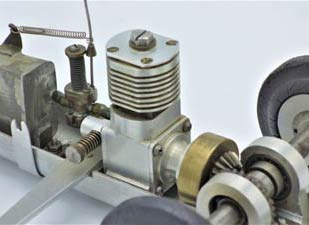 |
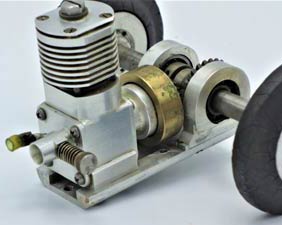 |
| In the 'spirit of a Shadow:
What appeared to be a nice, original, Ian Moore Shadow, proved anything but when the top was taken off. The entire car was fabricated, even the motor, which was base mounted in a separate engine/gear unit. The bearing ears were also fabricated and mounted on the same plate, which in turn was secured in the pan. There is a strong suspicion that the motor may well have been based on an Oliver and used some Oliver components, even to the extent of using a much modified Tiger MkII centre section. A wonderful piece of engineering that we currently know nothing more about. Thanks to John Goodall for this item and photos August 2021 |
||
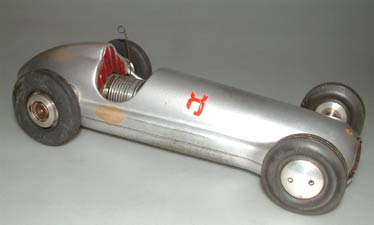 |
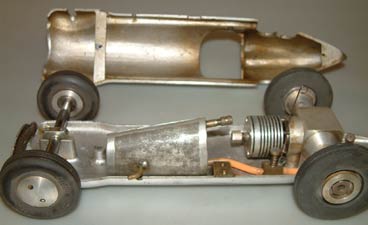 |
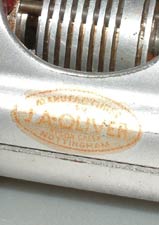 |
| Oliver Mercedes: These cars are relatively common, both originals from Oliver and more recently, a large number of reproductions. What makes this car unusual is that it was one of the factory produced and ready to run cars that the Company offered as an option. JAO confirmed that the decal was one they used on the frame tubes of the cycles that they produced before moving into model items. The decal bears the early Hyson Green address. An identical version of this model achieved an all time record price for an Oliver car when sold on eBay recently. Thanks to John Goodall for photos and Brian Ecclestone for the car July 2021 |
||
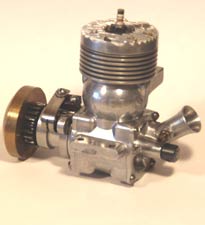 |
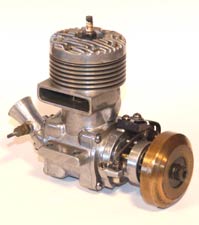 |
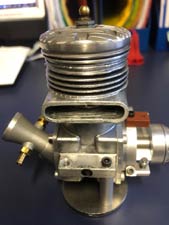 |
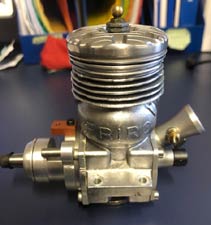 |
| Dooling Clones: For nearly 20 years from the late 1940s, the Dooling 61 and its offspring, the Yellow Jacket were dominant in the 10cc car class, but with post war restrictions, getting and paying for them was extremely difficult. This led to large numbers of copies being made, either as one offs or on a commercial basis. In Sweden, the Komet and from Switzerland the very successful AMRO. The AMRO was commissioned by Otto Amrein (AM) and produced by the Frtiz Rolli machine machine tool company (RO). Despite its huge success and sales, it was ultimately not finacially viable so Amrein relinquished his interest in 1959 and the motor became the FRIRO , the name of the Rolli company, FRIRO AG. The Amro is one of the most sought after racing engines for collectors and enthusiasts, but recently a quantity of FRIRO parts have emerged that are being assembled into complete units. Does anyone have an original AMRO? In 1955 the AMRO cost around £13, how much now? Thanks to John Goodall and Christoph Zaugg for images and information June 2021 |
|||
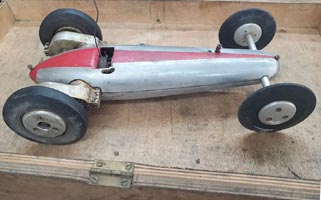 |
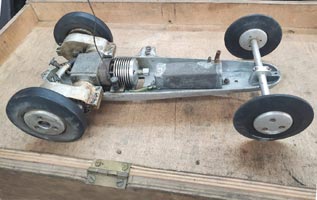 |
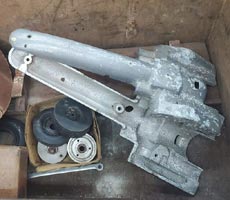 |
|
Faster Olivers: The Oliver Tiger twinshaft was the standard motor in 1.5cc and 2.5cc for many years, but increasing revs required ever smaller rear tyres until rotational speed and ground clearance became a problem. To overcome this, many competitors moved to gear drive through spur or bevel gears using aero Tiger motors, but others of a more inventive nature continued to use the twinshaft with two sets of gears as seen here with two of Jim Dean's cars. The complete car is a modified Oliver Bottom's Up with the twin gear cases, whilst lurking in the bottom of the box was a set of castings for his even more radical 'Incendiary'. Both cars are now in the US and attempts to garner further information has so far not proved fruitful. Images J Tilley May 2021 |
||
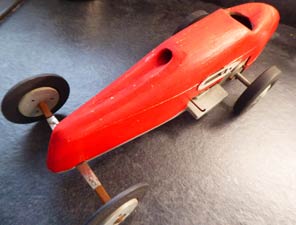 |
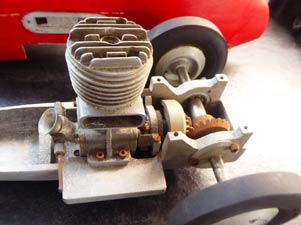 |
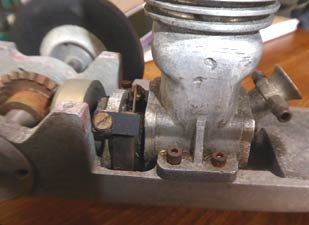 |
| Mystery Motor: This unfinished, 'bobtail' car revealed something very rare when the top was taken off, an engine that is so far only recorded on OTW and just the third of its type to be discovered. It is the last of the 1066 Conquerors to be built, the MkIV. These are easily identifiable by the much larger cylinder fins and huge bypass that is the same size as the equally large exhaust stack. This motor is so far unique in having the downdraught MkIV backplate fitted. There is a standard motor with this backplate that is in the A-Z but the only other complete version of this engine has a standard backplate. It seems that there might have been a casting flaw in the bypass so it has seen much attention from a file. A set of castings for this motor also exists making just three examples in total. Thanks to Ken Butterfield for this item and photos. April 2021 |
||
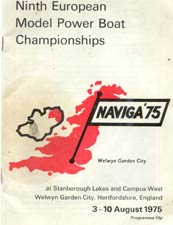 |
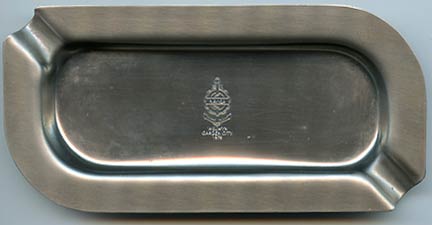 |
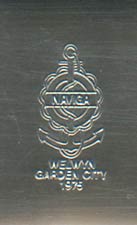 |
| Welwyn 1975:
The only European tethered hydroplane
Championship ever to be held in the UK was at Welwyn Garden City
in August 1975. At that time, every discipline of model power
boating had to be catered for at a championship, meaning an
absolutely enormous organisational task to cater for all the
visitors and classes. All that exists from this event is a
programme and stack of ash trays created as mementoes. Around
fifty hydro entries alone gives some idea of the scale of this
event. Items were from the collection of the late Keith Bragg, kindly passed on by Peter Hill March 2021 |
||
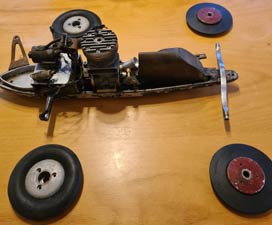 |
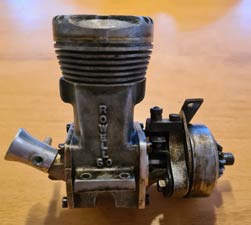 |
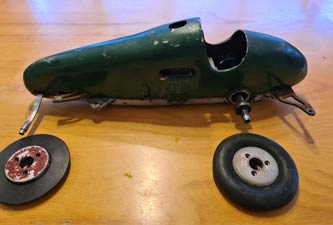 |
| Rowell Sabre? This car was bought by Dennis Cherkas in the early 1950s in Jersey. It is believed that a track did operate in the Channel islands at that time but no confirmation of this has been forthcoming. His wife has no recollection of him ever running it although the Edmonton track was not far from where they lived. Fast forward 60+ years and his grandson Hugh contacted us as he had dug it out of his father's garage and thought that it might be a Rowell Sabre. Certainly there is no doubt about the Rowell MkII engine, although this does not have a serial number. The Sabre was an almost direct copy of the Dooling Arrow, even down to the wheels and had the same, close coupled, bevel drive to the rear axle. The Sabre is distinctive for the definite angle in the pan, in line with the tank, so we are pretty sure that this is indeed a genuine Rowell although it has McCoy rear wheels and front tyres added by Hugh's father. There is only one other complete Sabre know to exist and that was Gerry Buck's but his vanished over 40 years ago and even that did not have an original Rowell body. The other is a reconstruction based on an original pan so this car is an absolute rarity and the intention is to replicate the missing parts and complete a sympathetic restoration. Thanks to Hugh Cherkas for this item, the photos, and importantly, identifying what this car might be. Feb 2021 |
||
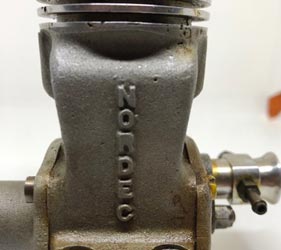 |
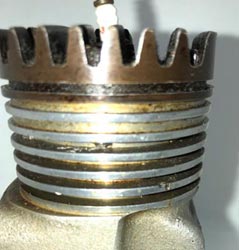 |
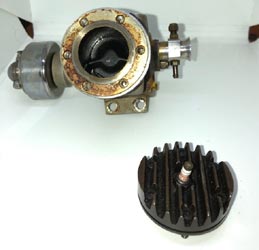 |
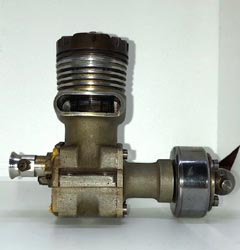 |
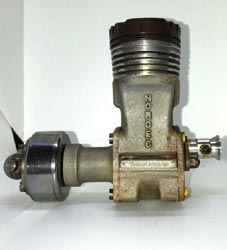 |
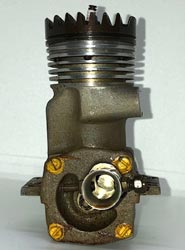 |
|
Nordec Special Series II: The first three photos reveal the significance of this engine and its true identity. The Special Series II was announced in 1950 and its most obvious feature was that unlike all the previous engines from the North Downs Engineering Company, this one has a monoblock crankcase, rather than separate cooling fins. This was serious attempt by designer, workshop manager and speed flyer John Wood to produce a motor that could compete with the McCoy. Peter Chinn tested this engine in Model Aircraft, reporting that it was certainly the most powerful Nordec so far. He also stated that production versions could revert to the separate fins. What remains a mystery is whether this version ever got beyond the pre-production prototype stage. So far, this is the only confirmed example to have been discovered and in strange circumstances. It has been resident in a Dooling F car since the early 1950s, hence the flywheel for a dog bone coupling. The car was originally owned by Hans Waeffler, first President of the Swiss Model Car Club so the engine had not been long out of the factory before it found its way into the car. The trimmed exhaust would indicate that it had seen service in a speed model before being transplanted, and the yellow paint on the rear cover screws gives us a realistic and intriguing possibility that this was John Wood's own engine as the paint matched his Little Rocket plane exactly. Wood also built a Series III but so far that only exists as a small scan from a magazine in the early 50s. A true 'sleeper' and an important discovery so thanks to Christoph Zaugg for spotting what it might be and supplying this super set of photos. January 2021 |
||
©copyrightOTW2021